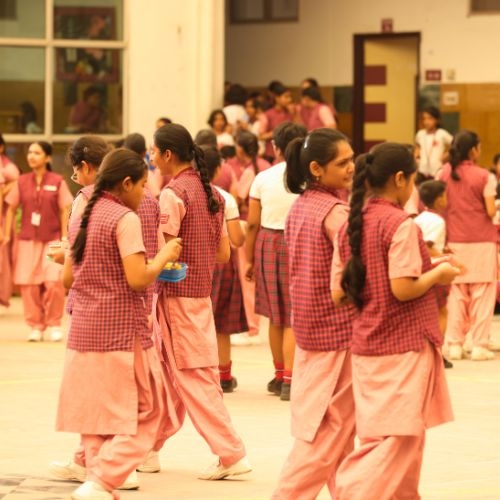

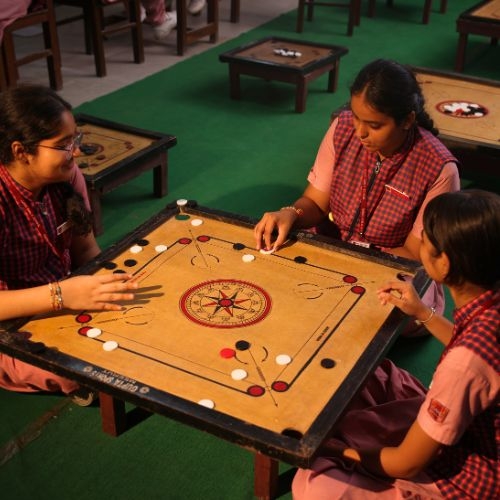
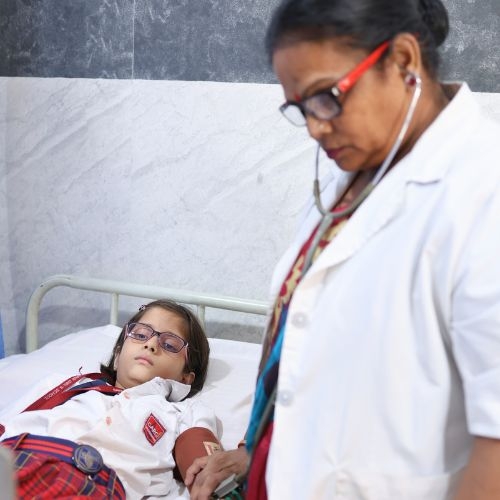

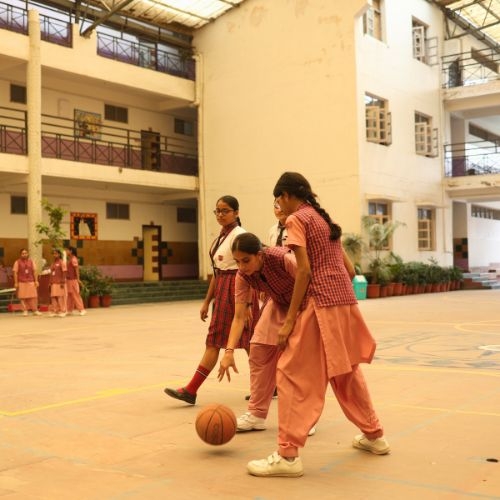
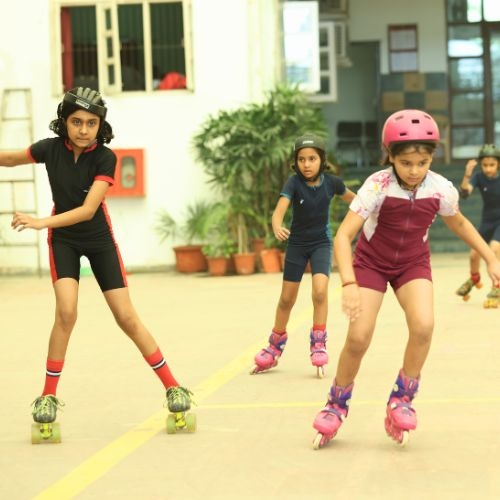


We prioritizes the well-being and safety of students by ensuring access to safe drinking water, adequate sanitation facilities, and effective waste management practices. We understand the importance of these fundamental necessities in creating a healthy and conducive learning environment for our students and other staff members. Here's a detailed description for achieving these goals.

●Safe Drinking Water: The school has implemented measures to ensure that students have access to clean and safe drinking water. The school has its own RO plant to supply clean and pure drinking water. We regularly test the quality of water sources within our school premises, including water storage tanks, chiller plants, taps, and RO systems as well. Certified agencies are hired to clean the tanks and service the RO system with vacuums and machines regularly complying with health and safety standards, School ensures that students are not exposed to any waterborne disease or contaminants. Our dedicated maintenance staff regularly checks the cleanliness of the drinking water area. Water samples get tested in laboratories every six months. We also conduct awareness campaigns to educate our students about the importance of drinking clean water and encourage responsible water usage.
●Adequate Sanitation Facilities: School is committed to providing proper sanitation facilities that cater to the needs of our students, promoting their comfort, hygiene, and dignity. Our school premises include an adequate number of separate and well-maintained toilets specifically designated for girls and boys. Separate Toilets for physically challenged students are also available on each floor. These toilets are equipped with necessary sanitation amenities such as clean toilets, running water, soap, and handwashing facilities. We have a team of dedicated janitors who ensure the cleanliness and hygiene of the toilets, conducting regular cleaning and disinfection routines. We also emphasize proper hygiene practices among our students, encouraging them to wash their hands with soap and water before and after using the facilities.

●Effective Waste Management: We place significant importance on responsible waste management practices to maintain a clean and sustainable environment within our school. Our waste management system includes designated waste disposal areas equipped with appropriate bins for different types of waste, such as recyclable, organic, and non-recyclable waste. We educate our students about the importance of waste segregation and promote the habit of recycling, reducing, and reusing materials. Through collaborative efforts with local waste management authorities, we ensure that waste generated within our school premises is collected, disposed of, and recycled properly. We conduct regular awareness campaigns and educational programs to instill a sense of environmental responsibility in our students.
●Ongoing Monitoring and Evaluation: To maintain the quality and effectiveness of our initiatives, we have established a system for ongoing monitoring and evaluation. We have appointed responsible staff members or a committee dedicated to overseeing the provision of safe drinking water, adequate sanitation, and effective waste management practices. Regular inspections and assessments are conducted to identify any areas for improvement or deficiencies in the implemented measures. We also actively seek feedback from students, parents, and staff to address concerns and make necessary adjustments to our policies and practices.
By diligently implementing these measures, we ensure that our school provides a safe, healthy, and hygienic environment for our students. We believe that access to safe drinking water, adequate sanitation facilities, and effective waste management contributes to their overall well-being, fosters positive learning experiences, and prepares them to become responsible global citizens.

We have a medical room on the ground floor. This room is a dedicated space where Students and other staff members can receive medical assistance and support. It serves as a primary point of contact for addressing various health concerns and promoting overall well-being among students. School has a full-time trained nurse, counselor, and a part-time doctor to deal with physical and mental health issues.
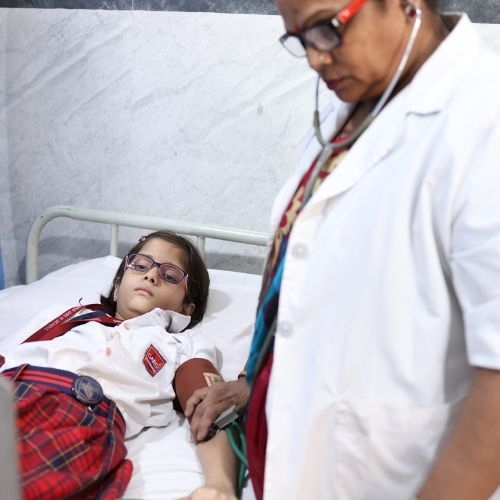
●Physical Examination Area: The medical room includes an area equipped for conducting basic health checkups and assessments. This area has an examination table, weighing scale, height measurement tools, and other necessary equipment for measuring vital signs.
●First Aid Supplies: The medical room is stocked with essential first aid supplies, such as bandages, antiseptics, adhesive tapes, and over-the-counter medications for common ailments like headaches, allergies, and minor injuries.
●Emergency Equipment: In case of emergencies, the medical room is equipped with emergency equipment like a first aid kit, oxygen supply, nebulizer, etc. The Nurse in the medical room is trained in handling emergencies.
To help build a strong relationship with parents, take the time to communicate with them about the good and the bad that you see in the classroom. There are tons of awesome apps for teachers that you can use, like Remind to easily share information.
●Health Checkups: The medical room conducts routine health checkups to monitor students' physical well-being. This includes measuring height, weight, blood pressure, vision, and hearing, and screening for certain medical conditions. These checkups help identify any underlying health issues and facilitate early intervention.
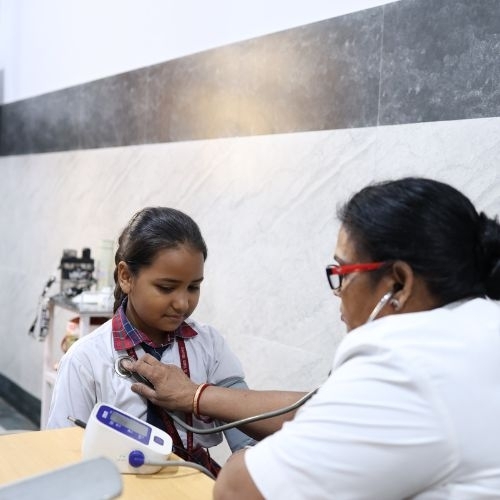
●Medication Management: In situations where students require regular medication, the medical room provides a secure area to store and administer prescribed medications. Trained staff members can ensure proper medication management and adhere to any specific protocols.
●Mental Health Support: Recognizing the importance of mental health, the medical room may offer support for students and staff facing mental health challenges. Trained counselors or mental health professionals can provide guidance, counseling, and referrals to appropriate resources when needed. Privacy and confidentiality are crucial considerations in these discussions.
●Resting Area: The medical room may have a designated area for students who feel unwell or need a quiet place to rest temporarily. This space includes two comfortable beds for students to lie down until they recover or receive further medical attention.
●Documentation and Records: The medical room maintains accurate and confidential records of students' visits, medical history, medications, allergies, and any specific health concerns. This information helps provide appropriate care and assists in communication with parents/guardians and healthcare providers. Health cards are also maintained with a special focus on immunization.

We are committed to fostering an eco-friendly environment that instills a sense of responsibility toward nature in our students. Our eco-friendly campus is designed to blend seamlessly with nature, providing an inspiring and nurturing environment for our students. We have implemented sustainable practices throughout our facilities including energy-efficient building, waste reduction programs, and water conservation initiatives.

●Eco-Friendly Orientation: Schools create an eco-friendly orientation and incorporating aesthetics, lawns, and green plants in schools not only enhances the overall ambiance but also promotes environmental consciousness among students.
Here are some High points from which we are achieving this:
●Waste Management: Gargi school has implemented a comprehensive waste management system with clearly labeled recycling bins for paper, plastic, and other recyclable materials. Encourage students to reduce waste and participate in recycling initiatives.
●Energy Conservation:Gargi School is using energy-efficient lighting and appliances throughout the school. Single point switch off system to Encouraging turning off lights and electronics when not in use. Considering using renewable energy sources, such as solar panels, to power the school.
●Water Conservation: Installed low-flow faucets and water-efficient toilets. Promote water conservation practices among students, such as fixing leaking taps and using water responsibly.
●Green Transportation: Encouraging students, staff, and parents to use eco-friendly transportation options like cycling, walking, carpooling.
●Curriculum Integration: Integrated environmental education into the school's curriculum, encourages students to learn about ecological concepts and sustainability.
●Eco Club:Established Eco clubs or eco-teams that actively work on environmental projects and initiatives, fostering a sense of responsibility and leadership in students.
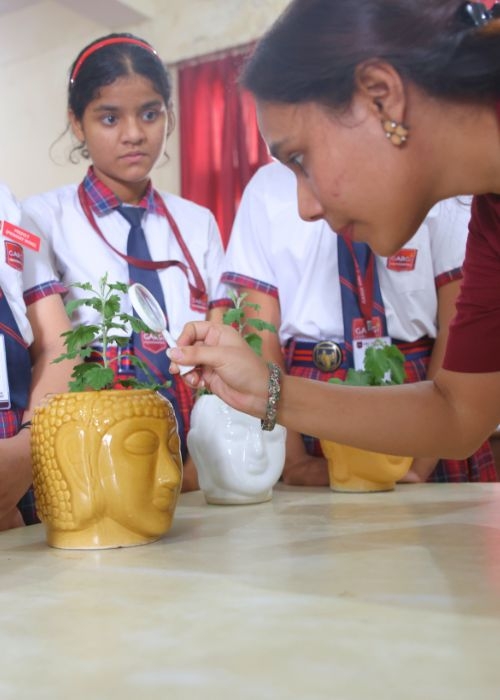
●Natural Materials: Incorporate natural and sustainable materials in the school's design and decor. Used wood, bamboo, or recycled materials for furniture and fittings.
●Earth Tones: Opted for earthy colors and natural tones in classrooms and common areas to create a calming and eco-friendly ambiance.
●Biophilic Design: Incorporated biophilic design elements that connect students with nature, such as indoor plants, green walls, and natural light.
●Native Plant Landscaping:Designed the school's lawn and landscaping with native plants that require less water and maintenance. Native plants also support local ecosystems and wildlife.
●Educational Gardens:Created educational gardens on the school grounds to teach students about gardening, biodiversity, and sustainable agriculture. Use these spaces to grow fruits, vegetables, and herbs that can be used in school.
●Tree Planting:Planted trees around the school campus to provide shade, improve air quality, and reduce the urban heat effect.
●By incorporating eco-friendly orientation, aesthetics, lawns, and green plants in the school, students will be exposed to a sustainable and environmentally conscious environment, encouraging them to adopt eco-friendly practices in their daily lives. It also sets an example for the community and demonstrates the school's commitment to environmental stewardship.Environmental education is a cornerstone of our curriculum reflecting our dedication to nurturing responsible and environmentally conscious citizens. Our goal is to instill a lifelong commitment to environmental stewardship, equipping students with the knowledge and skills to contribute to a sustainable future.